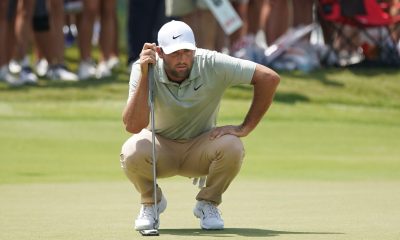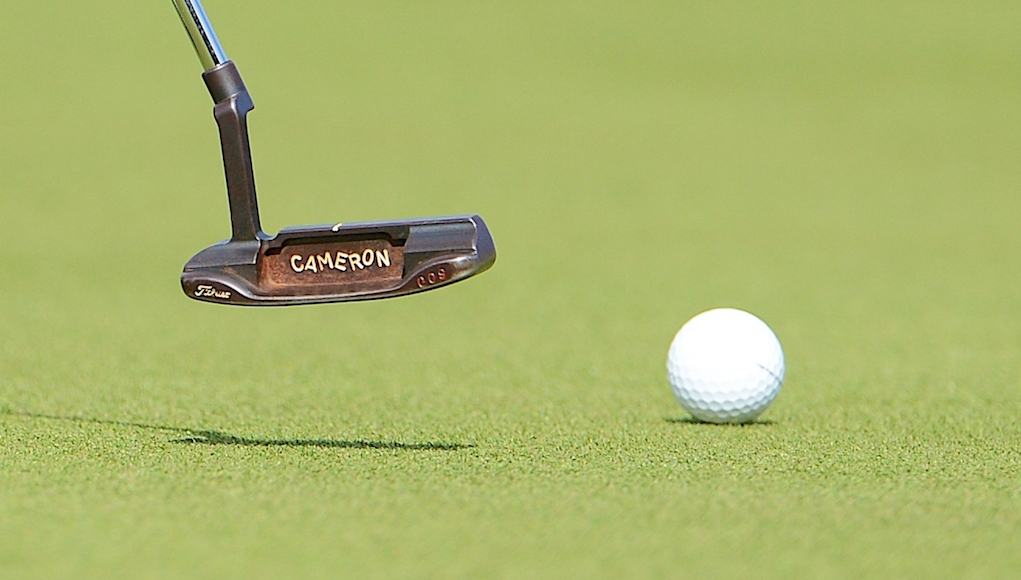Opinion & Analysis
Making the case for putting instruction

For most golfers, the thrill of the game is hitting the ball high, far and straight. I would go so far as to say that some players would rather set their hair on fire than spend an hour on the putting green three days a week. But most avid players would also give up something important to break a major scoring barrier like shooting in the 80’s for the first time. For the majority of golfers, whose time is limited but who still hope to play the golf of their dreams, putting lessons and proper putting practice are without doubt the most efficient way to spend practice time.
I should tell you that I am a certified instructor with the SeeMore Putter Institute and therefore have an interest in promoting putting instruction. However, the reason I became a putting teacher was that as a tournament player I know how much value there is in working on that part of my game. I also know I can help my students improve and enjoy golf more through putting instruction and putter fittings because putting involves a shorter, less complicated motion that they can practice at home, the office and at a golf course. So, first I am going to discuss some statistics that show why putting is so important for great scoring and overall golf enjoyment. Then I’ll address why you should spend your precious time learning how to putt from a qualified instructor.
Avid golfers know that a scorecard treats putting with the same importance as the long game. On a regulation par-72, 18-hole golf course with four par 3 holes, four par 5’s, and ten par 4’s, the scorecard allocates as many strokes for putting as for full shots from the tee and fairway. Because most of us miss a significant number of greens per round, the average golfer generally takes 45 percent of his strokes on the green. However, putting tops the list as the skill that determines overall scoring performance.
The PGA Tour’s Strokes Gained-Putting statistic is great at showing just how important the flat stick is. Columbia University Business School Professor Mark Broadie created the method of gauging putting performance, which measures the putts a player takes from a certain distance relative to the PGA Tour average “taking into account the initial putt distance on each green.” So, if a player makes a 35-footer, and the PGA Tour average from that distance is 2.0 putts, then he picked up a putt on the field. The number of times the player either gains or loses a stroke to his competitors during a round determines his ranking.
In 2012, Brandt Snedeker led the strokes gained category with an average of 0.860 strokes over 81 rounds, meaning he gained almost an entire stroke on a field of the best players in the world every time he teed it up. He won the Farmers Insurance Open, the Tour Championship and the $10 million FedExCup race, which is a test of consistency over the entire season. Despite being short and crooked compared to the rest of the TOUR (ranking 108th in driving distance, 106th in driving accuracy, and 126th in greens hit in regulation) Snedeker finished the season third on the money list behind only Tiger and Rory and won $4,989,739, and he’s off to an even better start in 2013. Luke Donald led the Strokes Gained-Putting category in 2011 on the way to topping the European Order of Merit and the PGA Tour money list titles. To those who say that golf has become strictly a “bomb and gouge” game, I say look at the numbers.
There is also a hidden message in these statistics that many folks who have spent time around golf already know. If two of the shorter hitters on TOUR were able to overcome that deficit with stellar putters, good putting must instill the type of confidence and grit no other part of one’s game can. The inverse is also true — strong ball striking and weak putting lead to the frustrated feeling that no matter how well a player hits the ball, he will never reach his full scoring potential.
Look at the number of wins and career money Boo Weekley, Kevin Sutherland, John Senden and Joe Durant have collected. These fine players have led or been near the top of the greens-in-regulation statistics for the past five years, but with all due respect, they would probably tell you that they wished they were better putters. The fact is that strong putting leads to the kind of good feelings that a player cannot get from hitting towering drives and laser-like approaches. Putting well reinforces that it is OK to take certain risks since a strong putter feels he can get up and down from 80 yards or from a tough lie on the short side of a green. Good putting controls momentum and confidence during a round of golf. Many golfers know this, but the vast majority of players do not do what is necessary to become consistently effective once they are on the green.
Putting a golf ball well is not an innate talent that some players are simply born with. Like other golf skills, putting takes some hand-eye coordination but it can be taught and improved with practice. Most players don’t really know where to start. Should the stroke be straight back and straight through, travel on an ellipsis, or from inside and then down the line? Like the full swing, there is so much conflicting information out there that it is hard for even a very good player to know what advice is best. If a player somehow finds the advice that is right, reading a book or magazine article does not guarantee that player is properly executing what he or she reads. We all need a qualified pair of eyes to give us feedback and guidance.
Enter the trained putting instructor
Compared to the general population of golf pros, trained putting teachers are rare. According to the PGA, only 6 percent of golf lessons include putting instruction and that does not mean the entire lesson was dedicated to putting. There are probably two reasons for this:
- Most golfers choose to focus on the long game when they hire a teacher, and many golf pros just do not feel comfortable teaching putting.
- To find a good teacher to help you with the most important part of your game, you will need to do a little research.
The SeeMore Putter Institute is a great place to start, but so are a number other great teachers who focus on the flat stick. Regardless of whom you learn from, the lessons and the practice should center around promoting pre-shot mental focus, and sound, neutral fundamentals — grip, alignment, posture and ball position — because that will facilitate repeatability in your stroke even with a limited practice schedule. If you work on these things for 20 minutes at home every other day and practice your putting for an hour once or twice a week on a putting green, I promise you will see long-term scoring dividends, and enjoy the game more.
Opinion & Analysis
The 2 primary challenges golf equipment companies face

As the editor-in-chief of this website and an observer of the GolfWRX forums and other online golf equipment discourse for over a decade, I’m pretty well attuned to the grunts and grumbles of a significant portion of the golf equipment purchasing spectrum. And before you accuse me of lording above all in some digital ivory tower, I’d like to offer that I worked at golf courses (public and private) for years prior to picking up my pen, so I’m well-versed in the non-degenerate golf equipment consumers out there. I touched (green)grass (retail)!
Complaints about the ills of and related to the OEMs usually follow some version of: Product cycles are too short for real innovation, tour equipment isn’t the same as retail (which is largely not true, by the way), too much is invested in marketing and not enough in R&D, top staffer X hasn’t even put the new driver in play, so it’s obviously not superior to the previous generation, prices are too high, and on and on.
Without digging into the merits of any of these claims, which I believe are mostly red herrings, I’d like to bring into view of our rangefinder what I believe to be the two primary difficulties golf equipment companies face.
One: As Terry Koehler, back when he was the CEO of Ben Hogan, told me at the time of the Ft Worth irons launch, if you can’t regularly hit the golf ball in a coin-sized area in the middle of the face, there’s not a ton that iron technology can do for you. Now, this is less true now with respect to irons than when he said it, and is less and less true by degrees as the clubs get larger (utilities, fairways, hybrids, drivers), but there remains a great deal of golf equipment truth in that statement. Think about it — which is to say, in TL;DR fashion, get lessons from a qualified instructor who will teach you about the fundamentals of repeatable impact and how the golf swing works, not just offer band-aid fixes. If you can’t repeatably deliver the golf club to the golf ball in something resembling the manner it was designed for, how can you expect to be getting the most out of the club — put another way, the maximum value from your investment?
Similarly, game improvement equipment can only improve your game if you game it. In other words, get fit for the clubs you ought to be playing rather than filling the bag with the ones you wish you could hit or used to be able to hit. Of course, don’t do this if you don’t care about performance and just want to hit a forged blade while playing off an 18 handicap. That’s absolutely fine. There were plenty of members in clubs back in the day playing Hogan Apex or Mizuno MP-32 irons who had no business doing so from a ballstriking standpoint, but they enjoyed their look, feel, and complementary qualities to their Gatsby hats and cashmere sweaters. Do what brings you a measure of joy in this maddening game.
Now, the second issue. This is not a plea for non-conforming equipment; rather, it is a statement of fact. USGA/R&A limits on every facet of golf equipment are detrimental to golf equipment manufacturers. Sure, you know this, but do you think about it as it applies to almost every element of equipment? A 500cc driver would be inherently more forgiving than a 460cc, as one with a COR measurement in excess of 0.83. 50-inch shafts. Box grooves. And on and on.
Would fewer regulations be objectively bad for the game? Would this erode its soul? Fortunately, that’s beside the point of this exercise, which is merely to point out the facts. The fact, in this case, is that equipment restrictions and regulations are the slaughterbench of an abundance of innovation in the golf equipment space. Is this for the best? Well, now I’ve asked the question twice and might as well give a partial response, I guess my answer to that would be, “It depends on what type of golf you’re playing and who you’re playing it with.”
For my part, I don’t mind embarrassing myself with vintage blades and persimmons chasing after the quasi-spiritual elevation of a well-struck shot, but that’s just me. Plenty of folks don’t give a damn if their grooves are conforming. Plenty of folks think the folks in Liberty Corner ought to add a prison to the museum for such offences. And those are just a few of the considerations for the amateur game — which doesn’t get inside the gallery ropes of the pro game…
Different strokes in the game of golf, in my humble opinion.
Anyway, I believe equipment company engineers are genuinely trying to build better equipment year over year. The marketing departments are trying to find ways to make this equipment appeal to the broadest segment of the golf market possible. All of this against (1) the backdrop of — at least for now — firm product cycles. And golfers who, with their ~15 average handicap (men), for the most part, are not striping the golf ball like Tiger in his prime and seem to have less and less time year over year to practice and improve. (2) Regulations that massively restrict what they’re able to do…
That’s the landscape as I see it and the real headwinds for golf equipment companies. No doubt, there’s more I haven’t considered, but I think the previous is a better — and better faith — point of departure when formulating any serious commentary on the golf equipment world than some of the more cynical and conspiratorial takes I hear.
Agree? Disagree? Think I’m worthy of an Adam Hadwin-esque security guard tackle? Let me know in the comments.
@golfoncbs The infamous Adam Hadwin tackle ? #golf #fyp #canada #pgatour #adamhadwin ? Ghibli-style nostalgic waltz – MaSssuguMusic
Podcasts
Fore Love of Golf: Introducing a new club concept

Episode #16 brings us Cliff McKinney. Cliff is the founder of Old Charlie Golf Club, a new club, and concept, to be built in the Florida panhandle. The model is quite interesting and aims to make great, private golf more affordable. We hope you enjoy the show!
Opinion & Analysis
On Scottie Scheffler wondering ‘What’s the point of winning?’

Last week, I came across a reel from BBC Sport on Instagram featuring Scottie Scheffler speaking to the media ahead of The Open at Royal Portrush. In it, he shared that he often wonders what the point is of wanting to win tournaments so badly — especially when he knows, deep down, that it doesn’t lead to a truly fulfilling life.
View this post on Instagram
“Is it great to be able to win tournaments and to accomplish the things I have in the game of golf? Yeah, it brings tears to my eyes just to think about it because I’ve literally worked my entire life to be good at this sport,” Scheffler said. “To have that kind of sense of accomplishment, I think, is a pretty cool feeling. To get to live out your dreams is very special, but at the end of the day, I’m not out here to inspire the next generation of golfers. I’m not out here to inspire someone to be the best player in the world, because what’s the point?”
Ironically — or perhaps perfectly — he went on to win the claret jug.
That question — what’s the point of winning? — cuts straight to the heart of the human journey.
As someone who’s spent over two decades in the trenches of professional golf, and in deep study of the mental, emotional, and spiritual dimensions of the game, I see Scottie’s inner conflict as a sign of soul evolution in motion.
I came to golf late. I wasn’t a junior standout or college All-American. At 27, I left a steady corporate job to see if I could be on the PGA Tour starting as a 14-handicap, average-length hitter. Over the years, my journey has been defined less by trophies and more by the relentless effort to navigate the deeply inequitable and gated system of professional golf — an effort that ultimately turned inward and helped me evolve as both a golfer and a person.
One perspective that helped me make sense of this inner dissonance around competition and our culture’s tendency to overvalue winning is the idea of soul evolution.
The University of Virginia’s Division of Perceptual Studies has done extensive research on reincarnation, and Netflix’s Surviving Death (Episode 6) explores the topic, too. Whether you take it literally or metaphorically, the idea that we’re on a long arc of growth — from beginner to sage elder — offers a profound perspective.
If you accept the premise literally, then terms like “young soul” and “old soul” start to hold meaning. However, even if we set the word “soul” aside, it’s easy to see that different levels of life experience produce different worldviews.
Newer souls — or people in earlier stages of their development — may be curious and kind but still lack discernment or depth. There is a naivety, and they don’t yet question as deeply, tending to see things in black and white, partly because certainty feels safer than confronting the unknown.
As we gain more experience, we begin to experiment. We test limits. We chase extreme external goals — sometimes at the expense of health, relationships, or inner peace — still operating from hunger, ambition, and the fragility of the ego.
It’s a necessary stage, but often a turbulent and unfulfilling one.
David Duval fell off the map after reaching World No. 1. Bubba Watson had his own “Is this it?” moment with his caddie, Ted Scott, after winning the Masters.
In Aaron Rodgers: Enigma, reflecting on his 2011 Super Bowl win, Rodgers said:
“Now I’ve accomplished the only thing that I really, really wanted to do in my life. Now what? I was like, ‘Did I aim at the wrong thing? Did I spend too much time thinking about stuff that ultimately doesn’t give you true happiness?’”
Jim Carrey once said, “I think everybody should get rich and famous and do everything they ever dreamed of so they can see that it’s not the answer.”
Eventually, though, something shifts.
We begin to see in shades of gray. Winning, dominating, accumulating—these pursuits lose their shine. The rewards feel more fleeting. Living in a constant state of fight-or-flight makes us feel alive, yes, but not happy and joyful.
Compassion begins to replace ambition. Love, presence, and gratitude become more fulfilling than status, profits, or trophies. We crave balance over burnout. Collaboration over competition. Meaning over metrics.
Interestingly, if we zoom out, we can apply this same model to nations and cultures. Countries, like people, have a collective “soul stage” made up of the individuals within them.
Take the United States, for example. I’d place it as a mid-level soul: highly competitive and deeply driven, but still learning emotional maturity. Still uncomfortable with nuance. Still believing that more is always better. Despite its global wins, the U.S. currently ranks just 23rd in happiness (as of 2025). You might liken it to a gifted teenager—bold, eager, and ambitious, but angsty and still figuring out how to live well and in balance. As much as a parent wants to protect their child, sometimes the child has to make their own mistakes to truly grow.
So when Scottie Scheffler wonders what the point of winning is, I don’t see someone losing strength.
I see someone evolving.
He’s beginning to look beyond the leaderboard. Beyond metrics of success that carry a lower vibration. And yet, in a poetic twist, Scheffler did go on to win The Open. But that only reinforces the point: even at the pinnacle, the question remains. And if more of us in the golf and sports world — and in U.S. culture at large — started asking similar questions, we might discover that the more meaningful trophy isn’t about accumulating or beating others at all costs.
It’s about awakening and evolving to something more than winning could ever promise.





















David
Sep 4, 2018 at 10:08 pm
I am keeping detailed putting stats for the rest of the year. Have my last 10 rounds and I’m committed to getting data for at least 100 rounds. Looking good so far, but still room for improvement, of course!
Paul Kaster
Mar 9, 2013 at 7:57 pm
Thanks Larry! As the saying goes, understanding is the first step to acceptance. More to come!
Paul
Larry Perfetti
Mar 8, 2013 at 7:08 pm
Okay, I’m convinced that I need to spend a lot more time on my putting and that that time will pay off in many ways on the course.
Now, I hope Paul follows this article with several articles describing the aspects of putting and drills that will help me become a better putter.
Great article.
Thanks,
Larry
Paul Kaster
Mar 1, 2013 at 8:44 am
Mark and Jeff, glad you liked the article and thanks for your comments! Remember to use whatever aides (or better yet instruction) you can – any practice is only as good as the reliable feedback that guides it. Keep at it and have fun!
Jeff
Feb 28, 2013 at 4:07 pm
Great article ! I’m glad all my golf buddies don’t believe articles like this . Just having a second set of eyes
Look at your alignment and where you’re aimed will take strokes off, let alone actual instruction from a pro. I love practicing the short game bc as you said , it frees up the long game knowing you can save par on off days
3Puttnomore
Feb 27, 2013 at 11:29 pm
I agree that some don’t want to spend time on a putting green every day.. which means that some do!… During the good weather I stop at my local course and spend an hour on the green 4 or 5 days a week!… I love it!
It relaxes me on my way home… I enjoy the late afternoon or early evening… And I get GREAT satisfaction from getting better at learning to read greens… I spend more time on a putting green than a driving range because you’re right, the best place to pick up strokes is there!
Thanks for the article… Enjoyed it…
Mark R.
Brampton, Ont.
Paul Kaster
Feb 25, 2013 at 9:45 pm
Thanks Kevin! I would love to see that data when you’re done. Accomplished players definitely reach parity at a certain level when it comes to ball striking. But I also think average golfers have the most gain by working on the fundamentals of putting and the short game – as Dr.Bob Rotella said in Golf is Not a Game of Perfect, you have to accept missing greens and fall in love with your wedge and putter to make real progress as a player.
Paul
kevin smith
Feb 26, 2013 at 1:51 pm
We had a booth at The PGA Show, and worked with alot of average golfers. I have little doubt the average golfer has the most to gain from working on Putting Fundamentals. The Players just need to add a little commitment and they can improve.
I will get you a copy of the data we come up with at the end of the spring season.
Kevin
Kevin Smith
Feb 25, 2013 at 2:11 pm
Could not agree more!! We are doing some putting coaching with our device at the division1 ranks and are in the process of compiling data. The one thing we see alot , is 5 minutes of putting practice then straight to the range .
Those in the “know”, know putting is where it is at!! As your competitive level increases ball striking becomes pretty equal.
Great Article
Kevin Smith
Get The Point Golf